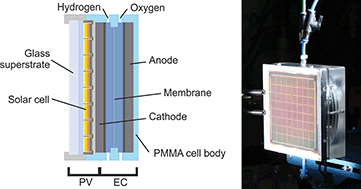A modular device for large area integrated photoelectrochemical water-splitting as a versatile tool to evaluate photoabsorbers and catalysts†
Abstract
We present a stand-alone integrated solar water-splitting module with an active area of 64 cm2 and a long-term stable operation. As a photocathode we employ multijunction thin film silicon solar cells that were optimized to deliver a suitable output voltage for spontaneous water-splitting. Two approaches for the design of a suitable front contact are presented to reduce series resistance losses related to the upscale of the photoelectrodes. The photoelectrode is protected from the electrolyte by a sheet metal which connects the rear contact of the solar cell with the hydrogen evolving catalyst. Thereby, the sheet metal ensures long-term stability while the electrical and thermal coupling of the solar cell and the electrolysis cell is maintained. Due to the modular setup, which allows us to vary and optimize the device components (i.e. the solar cell, catalysts, membrane, and electrolyte) individually, the presented water-splitting device provides a convenient toolbox for the optimization of such systems.

- This article is part of the themed collection: 2017 Journal of Materials Chemistry A HOT Papers


 Please wait while we load your content...
Please wait while we load your content...